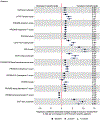Phenotyping of Urinary Urgency Patients Without Urgency Incontinence, and Their Comparison to Urgency Incontinence Patients: Findings From the LURN Study
- PMID: 36067368
- PMCID: PMC9742334
- DOI: 10.1097/JU.0000000000002939
Phenotyping of Urinary Urgency Patients Without Urgency Incontinence, and Their Comparison to Urgency Incontinence Patients: Findings From the LURN Study
Abstract
Purpose: We characterize patients with urinary urgency with vs without urgency urinary incontinence who presented to clinics actively seeking treatment for their symptoms.
Materials and methods: Participants who enrolled in the Symptoms of Lower Urinary Tract Dysfunction Research Network were categorized into urinary urgency with vs without urgency urinary incontinence. Participants were followed for 1 year; their urinary symptoms, urological pain, psychosocial factors, bowel function, sleep disturbance, physical activity levels, physical function, and quality of life were compared. Mixed effects linear regression models were used to examine the relationships between urgency urinary incontinence and these factors.
Results: Among 683 participants with urinary urgency at baseline, two-thirds (n=453) also had urgency urinary incontinence; one-third (n=230) had urinary urgency-only without urgency urinary incontinence. No differences were detected in urological pain between urinary urgency-only and urgency urinary incontinence. Those with urgency urinary incontinence had more severe urgency and frequency symptoms, higher depression, anxiety, perceived stress scores, more severe bowel dysfunction and sleep disturbance, lower physical activity levels, lower physical function, and worse quality of life than those with urinary urgency-only. Among those with urinary urgency-only at baseline, 40% continued to have urinary urgency-only, 15% progressed to urgency urinary incontinence, and 45% had no urgency at 12 months. Fifty-eight percent with urgency urinary incontinence at baseline continued to report urgency urinary incontinence at 12 months, while 15% improved to urinary urgency-only, and 27% had no urgency.
Conclusions: Patients with urgency urinary incontinence have severe storage symptoms, more psychosocial symptoms, poorer physical functioning, and worse quality of life. Our data suggested urgency urinary incontinence may be a more severe manifestation of urinary urgency, rather than urinary urgency and urgency urinary incontinence being distinct entities.
Keywords: lower urinary tract symptoms; overactive; urgency; urgency urinary incontinence; urinary bladder.
Conflict of interest statement
Conflicts of Interest
The authors declare no Conflicts of Interest.
Figures


Comment in
-
Editorial Comment.J Urol. 2023 Jan;209(1):242. doi: 10.1097/JU.0000000000002939.01. Epub 2022 Oct 10. J Urol. 2023. PMID: 36215652 No abstract available.
References
-
- D’Ancona C, Haylen B, Oelke M, et al. The International Continence Society (ICS) report on the terminology for adult male lower urinary tract and pelvic floor symptoms and dysfunction. Neurourol Urodyn 38: 433, 2019 - PubMed
-
- Stewart WF, Van Rooyen JB, Cundiff GW, et al. Prevalence and burden of overactive bladder in the United States. World J Urol 20: 327, 2003 - PubMed
-
- Tubaro A Defining overactive bladder: epidemiology and burden of disease. Urology 64: 2, 2004 - PubMed
-
- Hung MJ, Ho ES, Shen PS, et al. Urgency is the core symptom of female overactive bladder syndrome, as demonstrated by a statistical analysis. J Urol 176: 636, 2006 - PubMed
-
- Lightner DJ, Gomelsky A, Souter L, et al. Diagnosis and Treatment of Overactive Bladder (Non-Neurogenic) in Adults: AUA/SUFU Guideline Amendment 2019. J Urol 202: 558, 2019 - PubMed
MeSH terms
Grants and funding
LinkOut - more resources
Full Text Sources
Medical

